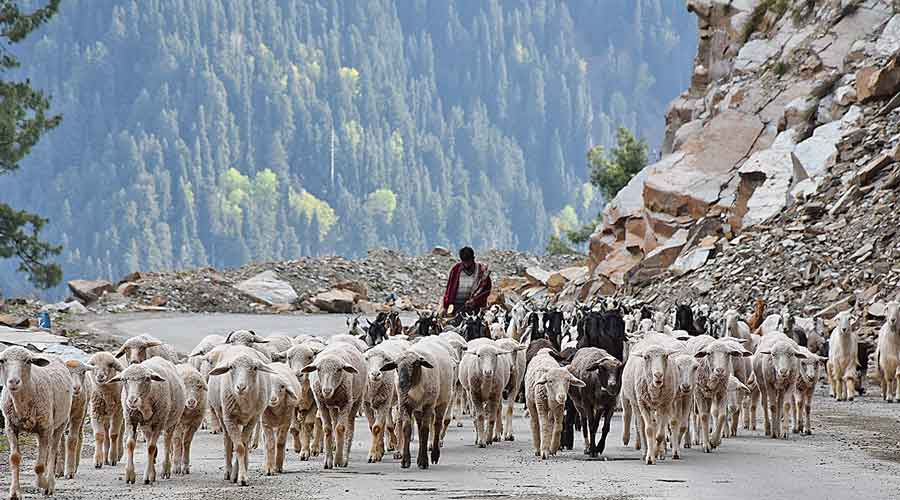Across the world, the formulation and execution of affirmative policy to correct real or perceived historical wrongs is a tricky affair. Current developments along the Line of Control in Jammu and Kashmir are a manifestation of this challenge. The cause of the acrimony is the demand by Paharis to grant them scheduled tribe status, which is being opposed by Gujjars and Bakerwals who are Muslim. Both communities comprise at least one-fifth of J&K’s population on the Indian side of the LoC.
The acrimony goes beyond contestation between the two groups. It brings to the surface the complex realities in J&K that are related to its diversity, political history and modern identity-formation that defy the monochromatic discourse. Gujjars and Bakerwals are spread across undivided J&K. The two communities share ethnicity and common saints. The Bakerwals are nomads and have flocks of goat and sheep, whereas the bulk of Gujjars are settled and dairy farming is the main occupation for a part of the community. As per official figures of 2017, nearly 32 per cent of Gujjars and Bakerwals have nomadic and semi-nomadic characteristics, with the majority of Gujjars being settled.
In the context of spreading militancy, with a nod from the former prime minister, Chandra Shekhar, the Gujjar-Bakerwals were granted the ST status on April 19, 1991. While Gujjars and Bakerwals are present across J&K, they have a higher concentration in areas near the LoC. A similar demand by another group, the Paharis, who inhabit areas near the LoC, had been pending.
The Gujjars oppose the granting of ST status to the Paharis as they fear that this will eat into their pie. With J&K’s legislative elections slated to take place in 2022, the recent resurgence of the Pahari demand has been met by hints from leaders of the Bharatiya Janata Party that it is being considered. Anxious over this development, the Gujjar community has taken to the streets. It has disputed the claim of Paharis being ‘tribal’, alleging that the ‘Paharis’ have no other glue except for a language and comprise people from diverse caste groups, including upper caste Muslims and Hindus. On the other hand, Pahari leaders have pointed out that only Bakerwals, who are nomadic tribes, actually fulfil the label of tribals. They argue that Gujjars, many of whom are settled, share their socio-economic conditions.
The official criteria for specification of a community as ST are as follows — indications of primitive traits; distinctive culture; geographical isolation; shyness of contact; backwardness. J&K, like Bengal and Punjab, underwent a radical change after 1947. Pahari identity is one such socio-political construction that has taken shape on this side of the LoC under the altered, post-1947 realities. Pahari language in J&K’s context, as it is recognized today, was construed to be one of the dialects of Punjabi. It got separate recognition in the 1911 census. Pahari-speakers were second in terms of numbers after Kashmiri-speakers in undivided J&K. Pahari is the language spoken by people along the areas near the LoC in both Kashmir and Jammu. Hindu and Sikh migrants, many of whom are now deceased, also speak this language across the LoC.
Affirmative policy necessitates a granular understanding of the issues rather than decisions undertaken on the basis of partisan political considerations. The design and targeting of the ST schemes for the Bakerwals had been weak and failed to address their nomadic character. There is lack of awareness and customization of grazing rights and rights to forest resources under the Scheduled Tribes and Other Traditional Forest Dwellers (Recognition Of Forest Rights) Act, 2006. A consistent fact that emerged in a series of interviews conducted by this author with various members of the Bakerwal community for the last two decades in various geographical locations is that a major chunk of the community remains ignorant of its rights. This is true even of the Bakerwals who have been educated in state-supported mobile schools that were started by the former chief minister, Sheikh Mohammad Abdullah, in the late 1970s. Even the mobile schools now reek of dysfunctionality and poor quality control.
The marginalization is a consequence of spatial and temporal issues. In the Kashmir Valley, the Kashmiri-speaking society is homogenous in terms of language and ethnicity irrespective of religion. Gujjars, with their own distinct culture, stand out in the Valley. Their economic integration is relatively less. The Wagay caste among Kashmiri-speaking Muslims deals with the dairy trade, the traditional preoccupation of Gujjars. The realities change to the south of Pir Panjal — Jammu division — which is heterogenous both in terms of religion and ethnicity. Apart from Gojri, Gujjars are conversant in other languages such as Pahari, Dogri and Punjabi. For centuries, like the Hindu Gujjars in parts of North India, Muslim Gujjars have been involved in dairy farming in J&K. In neighbouring undivided Punjab, Gujjar Muslims reportedly had a population of nearly 4.6 lakh in the 1901 census. The lens of marginalization in this particular context is similar to that of Hindu Gujjars in other parts of North India. In the same vein, there are several historically marginalized communities within the Pahari-speaking people, such as Lohars, Telis and so on.
In at least four assembly seats in areas along the LoC, Pahari leaders from all parties face political extinction because of reservation, a consequence of the abrogation of Article 370 in 2019, and are vociferously backing the demand. The demand is also an instrument to garner State employment. Unlike other parts of India, within J&K, there is little physical infrastructure that could create sustainable, long-term economic security in the non-State sector.
Bereft of comprehensive, inter-disciplinary knowledge, formulating a one-size-fits-all policy of affirmative action can have deleterious effects, including pitting one community against another. Such a worrying situation seems to be unfolding along the LoC.
(Luv Puri is the author of Across the LoC)










